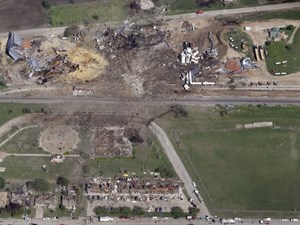And Now For Something Completely Different: Chemical Facility Safety?

For the past few days we have all been focused—justifiably—on the EPA’s proposed carbon rule for power plants. But that’s not all EPA and the rest of the federal government have been up to recently. Today a federal interagency working group established under Executive Order 13650, Improving Chemical Facility Safety and Security (“EO 13650”) issued its long-awaited report, outlining a plan of action for improving safety and security at the nation’s refineries and chemical plants. The interagency group, which includes EPA, OSHA, and Homeland Security, was charged with evaluating federal policies following the explosion at the West, Texas fertilizer plant in 2013.
Among other things, the working group was interested in whether “inherently safer technologies” should be integrated into current risk and process safety regulatory programs. “Inherently safer technology” is both a paradigm and a methodology. As a paradigm it offers an approach to chemicals management based upon prevention rather than control; it challenges facilities to permanently avoid or minimize hazards rather than reducing risk through engineering and administrative measures. It is an iterative methodology that considers preventive options, including eliminating hazard, reducing hazard, substituting a less hazardous alternative, and using less hazardous process conditions. Thus the EO 13650 process offered a unique opportunity for regulatory agencies to integrate the concept of prevention as a central component of chemical policy.
How did prevention fare in the action plan? Many environmental and labor groups and other stakeholders encouraged the agencies to make prevention real by requiring facilities to consider inherently safer technologies as part of process safety management and risk management planning. Industry commenters tended to come out the other way. The report calls for voluntary consideration of inherently safer technologies by industry, with the agencies issuing alerts and guidance aimed at increasing industry awareness of such approaches. It’s a start at least, but falls far short of recommendations made by the United States Chemical Safety Board in its reviews of several recent facility accidents. And the reliance on voluntary consideration and adoption of safer materials and processes seems at odds with legislative history. The Conference Report for the Clean Air Act Amendments regarding EPA’s Risk Management Program expressly stated that hazard assessments performed under Section 112(r)(7) “shall include . . . a review of the efficacy of various release prevention and control measures, including process changes or substitution of materials.” (A Legislative History of the Clean Air Act Amendments of 1990, 1451, 1790-1791 (1993) (H. Rept. 101-952 (October 26, 1990)).
But the journey continues. The working group report also notes that EPA will engage in rulemaking to modernize its Risk Management Program, including considering changes to the planning requirements to incorporate “examination of the use of safer technology alternatives.” Likewise the report states that OSHA will initiate rulemaking to update its Process Safety Management program, including the possibility of requiring that facilities perform “analysis of safer technology and alternatives.” Expect the usual suspects (including our own Sustainable Technology and Policy Program) to submit comments as they did under the EO 13650 process. Only time will tell whether EPA, OSHA or both will take the step forward towards prevention.
Reader Comments
One Reply to “And Now For Something Completely Different: Chemical Facility Safety?”
Comments are closed.







Timothy Malloy said;
“…..For the past few days we have all been focused—justifiably—on the EPA’s proposed carbon rule for power plants…..”
Dear Timothy,
Thanks for changing the subject. In retrospect, our meager words and dialogue is a microcosm of all that can realistically be “done” about climate change. Still it’s remarkable how quickly things change. It has been about a week since EPA rolled out its proposed carbon dioxide rules and all that can be said has been said, now it’s almost over. We can relax. Anyone who seriously wants to forget about it may do so now. Timothy – you are good welcomed relief, please continue.